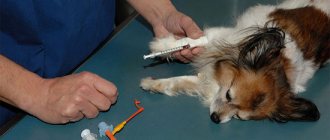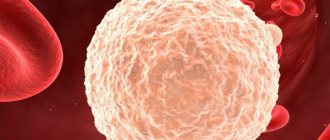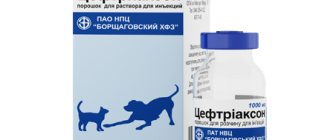Every owner who sincerely loves his pet should take tests to know if everything is in order in the body of his four-legged friend. The dog itself may not feel that something is wrong in its body. It is in this case that, as a rule, various tests are prescribed, among which there may be a phrase such as: increased alkaline phosphatase in the dog .
In this article we will examine in detail this element of the biochemical blood test. We will also consider the main reasons and factors due to which it can rapidly increase and pose a danger to your four-legged friend.
Normal Alkaline Phosphatase Levels and Functions
Alkaline phosphatase is an enzyme that takes part in the metabolic processes of phosphoric acid. It serves as a knife, separating this acid from various organic compounds. In this way, an extremely important element for the proper functioning of the biorobot, phosphorus, moves through the body.
Phosphatase transports phosphorus throughout the dog’s body
Alkaline phosphatase accumulates to a greater extent in the following segments of the dog’s body:
- animal skeletal tissues;
- the inner mucous layer of the dog's intestines;
- in the tissues of the placenta;
- inside the mammary glands at the time when the whelped bitch feeds her babies.
Veterinary medicine determines the normal levels of alkaline phosphatase contained in the body of a healthy dog:
- Thus, in an adult animal it can be up to 100 units per liter;
- in growing puppies, the required figure may increase slightly due to the fact that at their age there is active growth of bone tissue.
Unfortunately, an increase in the indicator of interest to us, detected in the study of blood serum, in fact cannot be a signal characteristic of any specific disease.
To determine an accurate diagnosis, additional studies and analyzes are needed.
Dog care and rehabilitation:
Depending on the reason for the appearance of alkaline phosphatase in dogs, care is chosen during and after treatment. The animal’s diet is usually adjusted if necessary. If there is excess fat, a light diet is prescribed on the menu (boiled chicken, a little rice, ready-made industrial feed with the required composition). They can add vitamins and microelements to preparations when a significant deficiency is detected. However, food is not always changed so that the dog does not receive additional stress and another increase in alkaline phosphatase.
In everyday life, the animal is treated kindly, the voice is not amplified, it is advisable to leave training for a while, exclude sports activities, running and very active walks. Going outside and meeting other animals is limited, which can cause strong emotions and severe fatigue. Physical activity is especially contraindicated for problems with the spine and limbs - various arthrosis, inflammation, destruction of bone tissue.
If alkaline phosphatase in dogs increases due to liver dysfunction, hepatoprotectors are usually prescribed. Serious diseases of the kidneys and gall bladder require special treatment. Sometimes, in particular in oncology, they resort to removing the affected organ or part of it. If a dog loses its voice, then this is a sign of a specific disease that is treated with specific drugs.
Causes of elevated alkaline phosphatase in dogs
According to the information available today, an increase in alkaline phosphatase in dogs can be provoked by various reasons, both causing concern and, on the contrary, completely natural.
What could be the reason for an increase in the level of the enzyme we are interested in in the dog’s body?
Table 1. Causes of elevated alkaline phosphatase in dogs
| Cause | Description |
| Taking medications prescribed by a doctor to treat a particular illness | So, provided that your animal is suffering from any illness for which the use of the remedies listed below is recommended, alkaline phosphatase may increase and will not affect the dog’s well-being at all. So, we are talking about:
|
| A certain state of the dog's body | So, some natural processes occurring in the animal’s body can cause tests to detect elevated levels of alkaline phosphatase in your dog. Let's list them:
|
| Pathological processes developing in the animal’s body | An increase in alkaline phosphatase can also indicate the development of many very unpleasant diseases, unfortunately, serious, often threatening the life of your pet, and minor, quickly cured. This is about:
|
| Belonging to a specific breed | Interestingly, one of all the breeds existing today in the world has an indicator such as alkaline phosphatase that is naturally elevated. We are talking about huskies - dogs that were bred by breeders for hard work in extreme conditions. Their metabolism ensures a constantly elevated level of alkaline phosphatase. In addition, this indicator may be higher than normal in husky mixes. |
Only representatives of one breed of all existing on earth and its mestizos initially have an increased level of alkaline phosphatase, and over time it does not decrease. We are talking about huskies, all dogs known today
Preparation for phosphatase diagnosis:
To determine whether alkaline phosphatase is increased in dogs or not, you need to take a biochemical blood test. In addition to the content of the enzyme itself, its results provide important information about other elements in the body. This will help with diagnosis. This test can be done in almost all veterinary laboratories. Before going to zoomedicine specialists, you will have to limit the animal in its usual things. For example, do not feed 8 hours in advance. Many products affect the indicators and they become useless.
Additionally, it is worth avoiding stress , even short-term, if the dog’s alkaline phosphatase level is very high. Reduce walks and serious exercise - let the animal have more peace and hormones, along with microelements, be in the normal state of the body. It is advisable to talk to the dog without raising your voice and not scolding him.
The veterinarian should ask about the animal’s diseases, its food, and medications that may affect the dog’s high alkaline phosphatase levels. Other features of preparation for research will be told by the staff of a particular laboratory or clinic; they may differ.
Symptoms of elevated alkaline phosphatase
Unfortunately, it will not be possible to diagnose an increase in alkaline phosphatase in dogs on your own without tests and studies, as, in general, there are no specific signs characterizing an increase in the amount of this enzyme. However, if it accompanies the development of any disease, you should pay attention to the following changes in the behavior and well-being of your pet:
- lack of interest in food, especially favorite treats, refusal of the required portion of food;
- lethargy, apathy, desire to sleep all the time;
- lack of interest in playing with the owner, as well as in receiving scratches and strokes;
- constant nausea, vomiting, expectoration;
- darkened urine;
- lightened stool;
- any behavioral deviations.
Loss of appetite is an alarming symptom
As you can see, the symptoms in this case are not at all unique; they are characteristic of almost all diseases. At the same time, you need to pay attention to them in any case, since a timely response and an immediate visit to the veterinarian can save the life of your pet, while “delay is like death.”
Symptoms of a developing disease
There are no definite signs that alkaline phosphatase is elevated in dogs. Animal owners should be alert to unusual behavior and typical signs:
- refusal to eat, complete loss of appetite;
- lethargic state of the animal, quickly setting in fatigue;
- nausea alternating with vomiting;
- dark urine, lightened stool;
- unusual behavior of a sick pet.
- identification of violations in the level of analysis is detected during diagnostic examinations.
Diagnosis of pathology
Carrying out diagnostic measures to detect an increase in the enzyme of interest to us is the competence of a veterinarian and no one else. You will not be able to independently diagnose your beloved animal completely and adequately, especially if you do not have a veterinary education. Needless to say, many owners simply do not know what alkaline phosphatase is, and that its increase is characteristic of the development of many ailments.
Diagnosis of pathology is made by a veterinarian based on tests and examination of the animal.
So, in order to understand that a pet is suffering from an illness associated with an increase in phosphatase, the doctor must carry out the following diagnostic measures.
1. First of all, a visual inspection of the dog brought to the appointment is necessary. This simple examination will help the doctor:
- exclude some obvious illnesses;
- form an opinion about the general condition of the dog;
- note deviations in her behavior and appearance, which may indicate any ailments.
After completing the general examination, you can begin more thorough external examinations.
To assess the full picture of the disease, the veterinarian also communicates with the owners of the animal and asks them if they have noticed any manifestations
2. It is imperative to palpate the animal's abdominal cavity (dog's belly). In this case, we will talk about identifying or, conversely, convincing in the absence of such phenomena as:
- local painful manifestations;
- enlarged dog liver, etc.
Provided that no abnormalities were detected during palpation, the doctor will proceed with further examination.
3. Assessing the coat is the third stage of the inspection. You will be surprised, but the condition of an animal’s fur can tell you about many things, including the presence of any problems in the body. So, provided that the assessment of the condition of the coat has been carried out, the doctor proceeds to collecting information from the owners and laboratory examinations, as well as hardware diagnostics
4. So, first of all, the veterinarian will begin interviewing the owners to describe the dog’s diet. So, in some cases, increasing alkaline phosphatase may be justified:
- overfeeding the animal;
- compiling a diet of fatty food that is not suitable for the dog;
- excess vitamin C in the animal menu;
- feeding “forbidden food” - sweets, chips and other prohibited animal products.
Animals picked up from the street or abandoned animals that have been cruelly treated, unfortunately, can often “boast” the desired increase in alkaline phosphatase, due to a whole “bouquet” of problems
Provided that such an imbalance in nutrition occurs, it is possible that the disease can be cured simply by changing the animal’s diet.
5. When information has been collected during the external inspection and interviewing the owners, it will be time to conduct a hardware examination. We are talking, first of all, about an ultrasound examination of the dog’s abdominal organs, which will show whether everything is in order in the animal.
Preparing a dog for an ultrasound
6. After receiving the ultrasound results or at the same time, biological fluids are submitted for analysis. So, most often veterinarians require blood tests:
- general;
- biochemical.
Provided that the cause of the disease is not clear, and the level of alkaline phosphatase in the animal’s blood continues to increase, the owner will be asked to leave the pet in the clinic for a series of examinations in a hospital setting and treatment.
How to properly prepare for blood biochemistry if you suspect an increase in alkaline phosphatase
As you know, in most cases, in order to obtain reliable results when conducting tests, it is necessary to first prepare the pet. Actually, this statement is also relevant for people, since we ourselves fast for a long time before a blood test.
Before taking a blood test to detect elevated levels of the enzyme we are interested in, the dog must not be fed for 8 hours immediately before the test
The owner of the dog whose blood will be taken is warned that the animal is prohibited before the test:
- for 8 hours, feed with any food, be it industrial food or homemade food (any food, in fact, contains the same substances that will have a negative impact on obtaining reliable results, changing their indicators);
- give something to drink other than plain water;
- A few days before the analysis, it is better to stop conducting regular training with the animal if it goes to a dog handler, prepares for competitions, or receives other intense physical activity.
Please note a very important fact: the fact is that if your pet is taking any medications, you must first inform the doctor about this.
Some medications may increase phosphatase levels
As we mentioned above, the following medications lead to an increase in phosphatase levels without any consequences:
- hormonal steroid drugs;
- non-steroidal medications that eliminate inflammatory processes in the body;
- vasoconstrictor drugs.
However, you need to understand that sometimes the processes taking place in the body of any living creature can be unpredictable, especially when they are influenced from the outside. Provided that your dog is taking medications not included in the list above, they can also affect the alkaline phosphatase level, or cause other changes in tests that will indicate the presence of active substances in the body, and not pathologies. Because medications may affect the results obtained, discuss with your veterinarian in advance:
- is it possible to cancel them;
- for a certain period of time to conduct a blood test;
- how exactly to cancel;
- and when to take the tests.
To reduce a pet's stress level, the owner must be there every second. This is an important element of therapy
In order to minimize the pet’s level of anxiety, which can make it even more ill, all procedures are carried out at a fast pace. In addition, you may not know, but stress can also affect the final results of tests prepared in the laboratory. That is why the owner must be present when materials are taken for analysis and inspection. Otherwise, not only the fear of needles and strangers, but also anxiety, and at the same time universal sadness from separation from the owner will be added to the pet’s anxiety.
Diagnosis of the disease
Carried out by a veterinarian when visiting the clinic:
- visual examination of a sick pet;
- palpation of the abdominal cavity to detect liver enlargement and painful manifestations;
- a thorough examination of the coat, its condition is assessed;
- collection of anamnestic data on the dog’s diet: quantity, types of products and whether there were cases of feeding prohibited types (sweets, etc.);
- referral for ultrasound examination of the abdominal cavity;
- taking a biochemical blood test, the result of which will make it possible to make the correct diagnosis.
With a stable increase in this indicator, the owner will be offered hospitalization of the pet for a full examination and prescription of the necessary treatment.
The analysis requires special preparation of the pet.
The owner is warned that the dog must spend at least 8 hours before delivery without feeding. Any food - store-bought, home-made - changes the final results, so it is better not to feed the animal, so as not to repeat the procedure;
- a few days before the manipulation, you should reduce physical activity - avoid training with a dog handler and long walks;
- If you are undergoing medication treatment, you must notify your doctor. Drugs affect the final data, and the veterinarian will choose the best time to undergo the study;
All procedures are carried out in an accelerated manner to reduce stress in the animal. Serious stressful situations can significantly change the indicators of this laboratory test, so the presence of the owner is necessary when taking tests.
Treatment of the disease
An increase in the amount of the enzyme we are interested in in a pet’s body cannot, in essence, act as a separate disease, since it is always a consequence of some kind of illness.
This means that elevated levels of alkaline phosphatase cannot be cured because it follows a specific disease.
The duty of the veterinarian is to study the animal’s tests and make assumptions about what caused the increase in the enzyme
The tasks of a doctor who has received an unsatisfactory analysis of a particular dog are as follows:
- discover the root cause of the increase in the disease;
- treat her;
- eliminate the negative impact of the clinical manifestations of this disease.
As a rule, after the root cause is eliminated, alkaline phosphatase levels always drop quite quickly, even during treatment, to their normal values
Unfortunately, conservative therapy (carried out only with the use of medications) is not always able to help your pet. In some cases, when it comes to damage to any organs, you have to part with part of a particular system. In other words, you may not be able to cope with medications alone, and surgery will be the solution to your problem.
By the way, even if conservative therapy in your case will probably have a certain beneficial effect, you need to understand that it should be prescribed by a doctor. You yourself do not have the right to choose:
- nor medicines;
- nor their dosage.
An increased level of phosphatase in a pregnant dog is an absolute norm, there is nothing to be afraid of
We ask you to remember once and for all: owners are prohibited from diagnosing illnesses in their pets and treating them themselves, as there is a high probability that you will harm the animal. The fact is that some medications can help a pet, while others will aggravate implicit negative processes in his body. If the drug or its dosage is selected incorrectly, the immediate death of the dog is quite possible.
Signs of liver disease
The activity of alkaline phosphatase increases in liver diseases and cholestasis. Treatment with glucocorticoids, narcotics and other drugs acting on the liver leads to increased activity. A moderate increase is noted in primary liver diseases - hepatitis, tumors. The greatest change in concentration is observed when the bile ducts are blocked.
Changes in alkaline phosphatase activity do not negatively affect the dog's body, as evidenced by an increase in its level in puppies. Therefore, all clinical changes are associated with the underlying disease. To make a diagnosis, it is necessary to take into account changes in organs and the use of a number of drugs.
Liver diseases are characterized by changes in blood biochemistry and clinical picture:
- increased bilirubin;
- increased enzyme activity;
- the appearance of jaundice;
- pain on palpation in the right side;
- enlargement of the liver border.
The causes of elevated alkaline phosphatase levels in dogs are most often associated with inflammatory processes in the liver and tumors. Hepatitis is caused by infections (viral hepatitis, leptospirosis, piroplasmosis, canine distemper), medications (glucocorticoids, barbiturates). The etiology of liver tumors is not fully understood.
Liver diseases are accompanied by a number of specific clinical changes. Yellowness of the mucous membranes, skin, and sclera of the eyes appears. The borders of the liver are usually enlarged, and tenderness is detected on palpation. Bilirubin and hemoglobin appear in the urine, causing it to become red. Urine volume and frequency of urination are increased.
Erosion and ulcers form on the mucous membrane of the gastrointestinal tract, which can be detected when examining the oral cavity. Damage to the stomach and intestines is indicated by vomiting blood and exhaustion. Dogs often develop abdominal hydrops.
Alkaline phosphatase levels change slowly in dogs and are poorly associated with disease severity and should not be considered for treatment evaluation.
In liver diseases, striking changes in blood biochemistry are observed. The activity of ALT and AST increases as a result of damage to hepatocytes. Also, their increase may indicate muscle injuries or the use of steroid hormones.
To clarify the diagnosis, a fatty acid test is performed. Plain radiography of the abdominal cavity reveals an increase in the borders of the liver. Ultrasound examination can determine the pathology of the gallbladder and liver tumors.
For treatment, infusion therapy is mandatory. Saline solution with the addition of 5% glucose, plasma or its substitutes are infused intravenously. The use of calcium supplements for bleeding is indicated. Severe blood loss may require a transfusion.
Erosive and ulcerative lesions of the intestine lead to the formation of putrefactive decay products, which causes toxic processes. It is necessary to reduce the activity of pathogenic microflora and remove toxins. Lactulose should be given internally, which acidifies the intestinal contents, reducing the number of bacteria. In addition, this drug binds ammonia. Administer 3-10 ml to dogs every 8-12 hours. At the same time, a course of antibiotics is used.
The important point is the right diet. A fasting diet is prescribed for a day, and then fatty foods are completely eliminated. Gradually, meat broths, rice and oatmeal porridges, and chopped vegetables are included in the diet. The daily norm is divided into 5-6 feeding meals.
Feeding during treatment and recovery period
Provided that doctors have detected a change in alkaline phosphatase levels, it is necessary to immediately change the dog’s diet. However, this must be done with caution.
Thus, doctors do not recommend completely replacing a dog’s usual food with any new one. However, it is strictly necessary to exclude canned food (for example, wet food), since during this period of time it is contraindicated for the body.
Wet food should be avoided
If the increase in the indicator was at all associated with the animal’s food, it is necessary to understand the specific reason for the changes, and:
- reduce the fat content of the animal’s diet;
- reduce the amount of food fed to the dog;
- Remove foods containing excess vitamin C from your diet.
Sometimes it happens that your animal’s attending physician decides to prescribe a specific therapeutic diet for your pet. In this case, you must follow his instructions 100% in order to cure your pet, so to speak, with little bloodshed.
If the doctor has prescribed a diet for your pet, your task is to follow it strictly.
Additional Precautions
In addition to following the specific rules for feeding the animal, which are relevant at the time of its undergoing medical procedures related to increasing the level of the enzyme we are considering, it is also necessary to follow the rules that will protect the pet’s health from deterioration and, on the contrary, will contribute to a faster recovery of the animal. Let's look at them.
1. So, first of all, you need to remember that while you are receiving treatment, your dog becomes “not travelable”. No, you can still take her for walks outside the city, however, traveling and even traveling to nearby areas is strictly not recommended, since climate change will have an extremely negative impact on the pet’s health.
If your dog is sick, it is better to hold off on traveling, acclimatization can have an extremely negative effect on it
Even for a healthy dog, as well as for a person, acclimatization threatens the restructuring of all processes occurring in the body, and is difficult. What can we say about a pet weakened by an illness, who devotes all his strength to basic recovery.
2. The second rule to follow when treating elevated alkaline phosphatase levels is that any stress to your pet during this time is like poison. Even small conflict situations will affect various processes in the animal’s body, and can aggravate the situation. We advise you to refrain from “showdowns” with your dog during treatment, even if there are behavioral disorders. It’s better to be patient, wait until the dog is fully recovered, and take him to a dog handler.
Your pet needs rest
3. The third rule means that your pet must strictly avoid unnecessary stress. So, during his illness you will have to give up:
- classes with a dog handler;
- preparatory training before competitions;
- preparations for exhibitions;
- games for walks;
- active games at home.
Provided that you are the owner of a very playful pet, you will have to pull yourself together and not respond to the dog’s offers to play. In addition, you will have to shift your walking time a little so that for a while you stop meeting your dog’s equally active friends with whom she is used to and really wants to play.
Refusal from active games is a necessary measure during the treatment of an illness that has caused an increase in phosphatase levels
Please note: a ban on excessive physical activity does not mean that you should wrap your dog in blankets and not even let him get up. Without movement, the body quickly becomes depressed. Your task in this case is to walk the dog at a calm pace, for a long enough time so that its muscle corset is strengthened, its organs receive enough blood and oxygen, and at the same time, so that overexertion does not occur.
What to do at home
In the postoperative period, great importance is attached to feeding. You should not suddenly change your diet and switch your pet from its usual natural food to ready-made food from well-known manufacturers. The food should be dietary, preference should be given to boiled dishes, for example, chicken.
A small amount of rice is allowed. Portions of food consumed, regardless of whether it is “natural” or prepared food, should be reduced.
During the rehabilitation period, it is not recommended to transport the dog to a new place of residence, visit noisy places, or allow contact with stray animals. Any stress can negatively affect the pet’s condition and provoke a relapse.
Prevention of disease in dogs
To ensure that you and your pet never experience elevated alkaline phosphatase, or to prevent the disease from recurring, you should resort to following the various preventive measures described in this section.
Don't let these measures seem complicated or dreary to you. As practice shows, following them, compared to further treatment, is much:
- easier;
- easier;
- cheaper;
- calmer.
Let's look at them in order.
Preventative measures will allow you to prevent your dog from developing a disease that causes an increase in the level of the enzyme we are interested in in the dog’s blood
Regular check-ups with a veterinarian
So, the first recommendation concerns regular visits to the veterinarian. Like humans, dogs periodically need to undergo examinations by doctors, the only difference being that the owners visit several specialists at a time, and the dog visits one, or at best two. However, regular examination, carried out every six months, accompanied by tests, as statistics show, can significantly reduce the risk of receiving tests with elevated phosphatase levels.
Even if your dog is completely healthy on the outside, negative processes can occur inside his body.
Regular examinations and tests from doctors can help you keep your dog 100% healthy.
The danger also lies in the fact that dogs, like cats and other animals, are very patient and may simply not show that they are in pain. A veterinarian's examination and tests will help stop the animal's suffering.
The correct daily menu for your pet
It is very important to properly plan your dog’s diet. We are not even talking about selecting the content of certain nutrients or fortifying them. We are talking about the elementary exclusion of products prohibited by veterinarians from the daily menu of dogs. We are talking about products such as:
- fatty meats and fish;
- semi-finished products;
- fried food (absolutely any);
- salty food;
- food flavored with spices (spicy foods are especially dangerous);
- baked goods and other flour products;
- sweets with any composition;
- food waste that people love so much, for example, chips, soda, ice cream, etc.
What the human body, or the dog’s body, sometimes cannot even digest, is difficult to bear, but endures. Thus, the substances contained in chocolate that are beneficial to us are not excreted in dogs.
In a special article, we will analyze in detail what you should not feed your dog, which foods are strictly prohibited for representatives of any breed, and can harm them.
It is allowed to feed the animal only healthy food; food waste must be excluded 100%
Even one small bar of real, pure chocolate can lead to the death of a pet. Regular intake of sugar provides animals with early blindness, spicy food disrupts the functioning of the stomach and intestines, and fatty foods “hit” the liver and pancreas of animals.
Remember, we are what we eat. This statement is also true for dogs. Food can already heal us and maintain the desired level of health.
Tracking your pet's overall health
Monitoring the general condition of the dog is your direct responsibility as the owner. The changes associated with it can manifest themselves in completely different ways. For example:
- the dog turns from cheerful to sad;
- The always calm dog is worried;
- love is replaced by aggression;
- drowsiness and apathy appear;
- food refusal occurs;
- new allergic reactions are unexpectedly detected;
- urine (darkens) and feces (lightens) change color;
- Dyspeptic disorders begin: vomiting, diarrhea, constipation, belching, etc.
If there are external changes in the dog’s condition, you should immediately take it to a doctor
Any changes that are not typical for your pet should cause you concern. Most likely, the animal is unwell and really needs to visit a doctor.
Prophylaxis of rickets in young animals
As we have already discussed, elevated alkaline phosphatase levels can occur in puppies. To ensure that it has natural causes and not pathological ones, veterinarians recommend preventing dogs from rickets. It includes the following aspects:
- include vitamin and mineral supplements in the dog’s diet, for example, specially purified fish oil with vitamins, and always with phosphorus and calcium, helps a lot;
- Regularly walk puppies in the sun to ensure that the body produces enough vitamin D.
Spend more time outside with your puppy
As you can see, it's not difficult at all. However, we strictly do not recommend selecting supplements on your own. This issue should also be entrusted to a veterinarian. Let him recommend more expensive products, the substances from which will be absorbed by the pet, than you buy the cheapest, and at the same time useless, products.
Checking mammary glands in lactating dogs
Another mandatory item is regular examination and palpation of the mammary glands of your dog who is nursing puppies. Not only is pregnancy itself a process that can trigger cancer, but also feeding sometimes aggravates the situation in the most negative way. It is not at all difficult to palpate a dog's mammary glands. The main thing is that you should not find any:
- seals;
- balls;
- tumors;
- thickenings, etc.
If you notice any of this, immediately go to the veterinarian; most likely, this is incipient oncology, which should be immediately prevented.
If a dog is feeding puppies, its mammary glands need to be checked
Protecting your pet from stress
It is the owner’s job to protect a beloved family member from stress. As we have already said, the presence of anxiety can greatly aggravate the animal’s health. In principle, we do not recommend solving dog behavior problems with physical violence, however, if you still use this method of punishment, it is time to abandon it.
Rudeness towards your pet during this time should also not be tolerated. The more upset the dog is, the worse it will become. Give up moralizing, wait until the dog recovers, and then, if necessary, solve the problems that arise with the dog handler.
The owner's love is a healing force. Support your pet in the fight against disease
Bone diseases
Phosphatase activity is associated with changes in bone tissue. Normally, young animals experience rapid skeletal development, which leads to an increase in the enzyme in the blood. Pathological cases include bone fractures and sarcomas. With a deficiency of calcium and phosphorus in the diet, dogs develop osteomalacia, which is also accompanied by changes in phosphatase levels.
Bone tumors in dogs are much less common than others (4% of cases). Middle-aged and older pets are predisposed to them. A predisposition is noted in large breeds of animals - Great Danes, Shepherds, Dobermans.
In most cases, the axial skeleton is affected, and in 50% of cases, osteosarcoma develops on the thoracic limbs. The bones of the skull and ribs are affected much less frequently. It is believed that this division is due to the distribution of the load - the bones of the front legs bear the greatest pressure.
The development of a tumor is associated with impaired growth of bone cells. Therefore, the distal areas where bone growth stops most lately, the areas with fractures, are the first to suffer. Osteosarcoma is especially common when bones do not heal properly due to the use of metal structures.
- in the initial stage, lameness appears during periods of heavy exertion;
- after 1-2 months the lameness intensifies, the ability to move is lost;
- muscle atrophy develops;
- swelling appears at the site of tumor development;
- pathological mobility appears at the sites of bone fractures;
- the skin over the tumor is ulcerated.
Damage to the ribs leads to breathing problems. Gradually, the neoplasm spreads along the bone marrow canal, covering the entire bone. At the same time, metastases are distributed throughout the body through the bloodstream. Secondary tumors are often found in the lungs, kidneys and liver.
To clarify the diagnosis, an X-ray of the affected area is performed, and a survey image allows one to identify metastases to assess the prognosis. An x-ray image reveals a focus of bone tissue destruction - it does not have a clear boundary, and a protective barrier does not form around the affected area. A biopsy is required to differentiate from other tumors and osteomyelitis.
Treatment for osteosarcoma includes surgery, radiation, and chemotherapy. At an early stage, before metastases form, the damaged area is removed (limb amputation). In most cases, this allows you to extend the pet's life by several months. Surgical intervention is ineffective or dangerous when the flat bones of the skull and ribs are affected.
In this case, radiation therapy is performed. Irradiation is carried out in several stages and, depending on the stage of tumor development, can allow the dog to live for another 3-5 months. Treatment is much more effective if surgical methods are supplemented with chemotherapy. This allows you to avoid the spread of metastases and reduce the growth activity of tumor cells.
Every owner who sincerely loves his pet must undergo tests to know if everything is in order in the body of his four-legged friend. The dog itself may not feel that something is wrong in its body. It is in this case that, as a rule, various tests are prescribed, among which there may be a phrase such as: increased alkaline phosphatase in the dog.
In this article we will examine in detail this element of the biochemical blood test. We will also consider the main reasons and factors due to which it can rapidly increase and pose a danger to your four-legged friend.
Let's sum it up
The sooner you contact a veterinary clinic if you notice any deviations in the behavior and well-being of your pet, the more likely it is that an increased level of alkaline phosphatase will be diagnosed, which means that the root cause of changes in the indicators for this enzyme will quickly be determined.
Next, the doctor will select the appropriate treatment for your pet, and he will soon recover. In the most severe cases, when the pet still cannot be cured, the doctor helps alleviate its suffering and seriously improves the animal’s quality of life. Be that as it may, the day you got a dog, the responsibility of caring for it and responsibility for the animal’s condition fell on your shoulders. Take the issue of your pet's health seriously, and most likely everything will end well for both of you.
Why does CPK increase?
The job of creatine kinase is to accelerate the delivery of the phosphoryl moiety from adenosine triphosphate (ATP) to creatine. In the process, adenosine diphosphate is released, due to which the energy previously hidden in the high-energy bonds of ATP is actively used.
Thus, creatine phosphokinase is involved in a complex biochemical process that supplies energy to the muscles, without which they cannot contract. CPK forms three isoenzymes, which, in turn, consist of two isoenzymes - M and B.
The brain is represented by MV subunits, the myocardium - MV (about 40%), skeletal muscles - MM.
Normal creatine kinase levels are 32-157 units. An increase in the enzyme in the blood indicates serious indicators occurring in the animal’s body, such as:
- myocardial infarction;
- stroke;
- myocarditis;
- muscular dystrophy;
- damage to brain tissue, including its decay due to oncology;
- Reye's syndrome;
- operations, injuries;
- polymyositis;
- infections;
- strong physical activity;
- intoxication;
- anesthesia
Indicators may increase slightly in case of arthritis, heart failure, tachycardia.
What do you prefer to feed your pets?
Poll Options are limited because JavaScript is disabled in your browser.
- Porridge with various additives 46%, 7427 votes
Blood parameters in dogs with chronic hepatitis
Federal State Educational Institution of Higher Professional Education "Saratov State Agrarian University"
Chronic hepatitis is a polyetiological disease characterized by inflammation and necrosis of the liver parenchyma, which persists for at least 6 months. In mild cases, the disease does not progress or progresses slowly. In severe cases, fibrosis develops with a violation of the liver architecture, and over time, liver cirrhosis develops.
The liver, being the metabolic center of the body, performs a number of important functions, integrating its various systems and metabolic processes, thereby determining the maintenance of homeostasis in the body.
The studies were conducted on dogs of different breeds and ages. A total of 80 animals diagnosed with chronic hepatitis were studied. In complex treatment, the method of both diet therapy and the complex use of new generation hepatoprotectors was assessed based on changes in biochemical blood parameters, clinical signs and general condition. The studies were conducted on dogs of various breeds. In all selected animals, based on the collection of anamnesis data, clinical signs and laboratory tests, a chronic course of hepatitis was revealed to one degree or another. Sick animals in complex treatment with hepatoprotectors were fed the Royal Canine veterinary diet (Hepatic).
The most common disorder of clinical signs was diagnosed from the digestive and nervous system (poor appetite, anorexia, vomiting, depression, cachexia, etc.).
All animals studied were vaccinated. The average age of the dogs was 6 years. Most often, this pathology was recorded in dogs aged 4 to 12 years. 10% of the studied dogs are registered with chronic hepatitis of early age (up to two years) and, as a rule, have congenial (congenital) pathology. Among the breeds presented in the study, the most frequently registered are: German Shepherd, Airedale Terrier, Giant Schnauzer, Caucasian Shepherd and Cocker Spaniel.
During the course of chronic hepatitis in dogs, the biochemical parameters of blood plasma changed most demonstrably, especially the catalytic activity of organ-specific enzymes (alkaline phosphatase, cholinesterase, ALT, AST, LDH).
Aminotransferases belong to the group of indicator enzymes and do not have organ specificity, however, the high sensitivity and early informativeness of studying the activity of these enzymes can serve as a starting integral criterion for assessing the functional state of the liver in hepatitis in dogs.
1. Dynamics of organ-specific enzymes in dogs during the treatment of chronic hepatitis
An increase in aminotransferases in the blood serum of dogs with chronic hepatitis indicates the depth of damage and the activity of the pathological process in the liver.
Analysis of the table data shows a decrease in intense cholinesterase activity, which allows us to judge the quantitative characteristics of the severity of the disease (P
With the use of hepatoprotectors and the inclusion of dietary therapy in the diet, the activity of alkaline phosphatase, ALT, AST and LDH levels were normalized to the limits of physiological fluctuations. A positive trend in the development of catalytic activity of enzymes during this therapy is characteristic.
The catalytic activity of cholinesterase increased after therapeutic and dietary intervention, indicating the positive dynamics of reparative processes.
The final data on the dynamics of chronic hepatitis during therapy reflect the results of laboratory urine tests (Table 2). After just 4 days, the levels of protein, sugar, and indican decreased. After 16 days of this therapy, trace amounts of indican and urobilin were determined. The clinical condition of the dogs improved with this treatment: appetite was restored, the activity of the gastrointestinal tract and cardiovascular system was normalized.
The use of hepatoprotectors and the inclusion of dietary foods in the chronic form of hepatitis has a pronounced therapeutic effect, manifested by the normalization of indicators characterizing the functional state of the liver and the normalization of the general clinical condition. The dynamics of biochemical blood parameters, especially the catalytic activity of organ-specific enzymes during combined diet therapy and homeopathic treatment in dogs with hepatopathy proves the validity of this treatment.
2. Urological syndrome of dogs with chronic hepatitis
The use of combined treatment of dogs for this pathology has a pronounced therapeutic effect, manifested by stabilization of indicators characterizing the functional state of the liver and normalization of the general clinical condition.
You need to take your beloved pet to the veterinarian, even if he seems to be completely healthy. This opinion is often wrong. In order to be confident in the health of your pet, you need to have his blood tested, get all vaccinations according to the schedule, and, of course, look after him, comb him, walk him, bathe him and feed him quality food. But why they take tests for a biochemical blood test in dogs will be discussed in this article.
What is biochemical analysis and why is it needed?
A blood test is a very important factor in a pet’s health, because it allows us to identify many diseases and abnormalities. But some owners neglect to examine their dog. Unfortunately, this leads to serious problems that could have been eradicated at the beginning of development. Biochemical analysis allows you to examine the tissues and internal organs of a dog for various diseases and abnormalities. The areas mainly examined are the liver, heart and kidneys. Typically, this procedure is prescribed by a doctor. However, you can come and order it yourself to monitor your pet. If there are no deviations, then it is recommended to bring your dog for testing no more than once a year.











